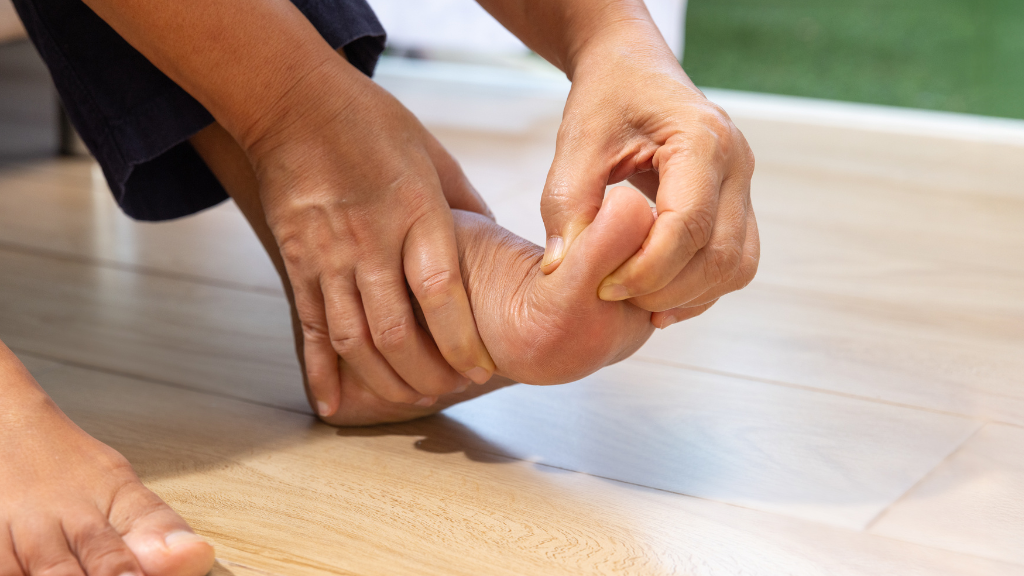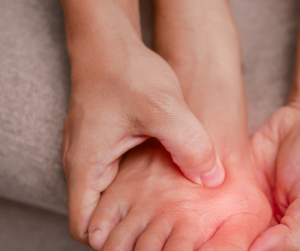Big toe arthritis, also known as hallux rigidus, is a common and often debilitating condition characterised by degeneration of the cartilage in the big toe joint. This “wear and tear” arthritis type specifically affects the big toe main knuckle, or metatarsophalangeal (MTP) joint, which is crucial for foot movement. As the cartilage deteriorates, pain and stiffness ensue, significantly impacting a person’s mobility and quality of life.
Understanding Big Toe Arthritis
Anatomy of the Big Toe
The big toe, or hallux, is composed of two bones: the proximal phalanx and the distal phalanx. The MTP joint connects the proximal phalanx to the first metatarsal bone of the foot. The metatarsal bones run between the ankle and the toes, under the skin where shoe laces wound tie. This big toe MTP joint is crucial for walking, running, and balancing as it allows the toe to bend and flex.
Function of the Big Toe Joint
The primary function of the big toe joint is to provide stability and propulsion during movement. The joint plays a critical role in the push-off phase of walking and running, where it helps transfer the body’s weight from the heel to the toes and propels the body forward.
What is Big Toe Arthritis?
Definition and Types of Big Toe Arthritis
Big toe arthritis refers to the degeneration of the cartilage in the MTP joint, leading to pain, swelling, and reduced mobility. There are different types of arthritis that can affect the big toe, including:
- Osteoarthritis: The most common type, characteried by the wear and tear of the cartilage.
- Rheumatoid Arthritis: An autoimmune condition that causes inflammation of the joint lining.
- Post-traumatic Arthritis: Arthritis that develops after an injury to the big toe.
Symptoms of Big Toe Arthritis
Common symptoms include:
- Pain and tenderness in the big toe, especially during movement.
- Stiffness and limited range of motion.
- Swelling and inflammation around the joint.
- Formation of bone spurs.
- Difficulty wearing certain shoes due to discomfort.
Causes and Risk Factors
Causes of Big Toe Arthritis
Several factors can contribute to the development of big toe arthritis:- Aging: Natural wear and tear over time.
- Genetics: A family history of arthritis can increase susceptibility.
- Injury: Previous fractures or sprains can lead to arthritis.
- Overuse: Repetitive stress from activities like running or dancing.
Risk Factors
Certain conditions and lifestyle choices can increase the risk of developing big toe arthritis:- Obesity: Excess weight puts additional stress on the joints.
- Foot Structure: Abnormalities like flat feet or high arches.
- Gender: Women are more likely to develop certain types of arthritis.
- Occupations: Jobs that require prolonged standing or walking.


How Is Big Toe Arthritis Diagnosed?
Clinical Examination
A thorough clinical examination by a healthcare provider is the first step in diagnosing big toe arthritis. This typically involves:- Reviewing the patient’s medical history.
- Assessing symptoms and their impact on daily activities.
- Physical examination of the foot, including checking for tenderness, swelling, and range of motion.
Imaging Tests
Imaging tests can help confirm the diagnosis and assess the extent of joint damage:- X-rays: Reveal joint space narrowing, bone spurs, and other changes.
- Standing CT: This shows the bone in 3D, and when standing.
- MRI: Provides detailed images of the soft tissues and cartilage.
- Ultrasound: Can detect inflammation and soft tissue abnormalities.
What are the Treatment Options for Big Toe Arthritis?
Non-Surgical Treatments
Several non-surgical treatments can help manage the symptoms of big toe arthritis:- Medications: Nonsteroidal anti-inflammatory drugs (NSAIDs) to reduce pain and inflammation.
- Stiff-soled shoes: Less bending of the toe helps.
- Physical Therapy: Exercises to improve joint mobility and strengthen surrounding muscles.
- Orthotic Devices: Custom insoles or shoe modifications to alleviate pressure on the big toe.
- Lifestyle Modifications: Weight management and activity modification to reduce stress on the joint.
- Injections: Corticosteroid injections to reduce inflammation and pain.
Surgical Treatments
When non-surgical treatments are ineffective, surgical options may be considered.- Cheilectomy: Removal of bone spurs and part of the foot bone to improve joint mobility.
- Arthrodesis (Fusion): Fusing the bones of the joint to eliminate pain and provide stability.
- Joint Replacement: Replacing the damaged joint with an artificial implant.
Rehabilitation and Recovery From Big Toe Arthritis
Post-Surgical Rehabilitation
Rehabilitation is crucial for recovery after surgery for big toe arthritis:
- Physical Therapy: A structured program to restore mobility and strength.
- Gradual Weight-Bearing: Slowly increasing weight-bearing activities as healing progresses.
- Pain Management: Medications and techniques to manage post-operative pain.
Long-Term Management
Long-term management strategies can help prevent recurrence and maintain joint health:
- Regular Exercise: Low-impact activities to maintain joint flexibility and strength.
- Healthy Diet: Nutrient-rich diet to support joint health and weight management.
- Footwear: Wearing appropriate shoes with good support and cushioning.


Living with Big Toe Arthritis
Coping Strategies
Living with big toe arthritis can be challenging, but several strategies can help:- Pain Management: Using medications and alternative therapies like acupuncture.
- Adaptive Devices: Using a walking tick to reduce pressure on the affected joint.
- Support Groups: Joining support groups for emotional support and shared experiences.
Lifestyle Adjustments
Making certain lifestyle adjustments can improve daily functioning:- Activity Modification: Avoiding activities that exacerbate symptoms.
- Home Modifications: Making changes at home to reduce the risk of falls and accommodate mobility limitations.
Prevention of Big Toe Arthritis
Preventive Measures
While it may not be possible to prevent big toe arthritis entirely, certain measures can reduce the risk:- Maintaining a Healthy Weight: Reducing stress on the joints.
- Proper Footwear: Wearing supportive shoes that fit well.
- Avoiding Repetitive Stress: Modifying activities that put excessive stress on the big toe.
Early Intervention
Early intervention can help manage symptoms and slow the progression of arthritis:- Regular Check-ups: Seeing a healthcare provider for early signs of joint problems.
- Timely Treatment: Seeking treatment promptly for foot injuries.
Advances in Big Toe Arthritis Research
Current Research
Ongoing research is focused on understanding the underlying mechanisms of arthritis and developing new treatments. None of these ideas has yet brought any proven benefit to patients, but you may read about:
- Regenerative Medicine: Exploring the potential of stem cells and tissue engineering.
- Biologic Therapies: Investigating the use of biologic agents to reduce inflammation and promote healing.
Future Directions
Future research may lead to innovative treatments and improved outcomes for patients with big toe arthritis:
- Personalised Medicine: Tailoring treatments based on individual genetic profiles.
- Advanced Surgical Techniques: Developing less invasive surgical options with quicker recovery times.
Resources and Support
Support Groups and Organizations
Several organizations and support groups can provide valuable resources and support:
- Arthritis Foundation: Offers information, resources, and support for people with arthritis.
- Local Support Groups: Join local groups to connect with others facing similar challenges.
Finding a Specialist
At the London Foot and Ankle Centre, our specialists offer expert diagnosis and treatment for stubborn cases of big toe arthritis. To make an appointment get in touch via our contact form or contact us at:
Conclusion
Big toe arthritis is a common condition that can significantly impact a person’s quality of life. Understanding the anatomy, causes, symptoms, and treatment options is crucial for effective management. Early diagnosis and intervention, combined with appropriate lifestyle modifications and treatments, can help alleviate symptoms and improve mobility. Ongoing research holds promise for new and innovative treatments that may further enhance the lives of those affected by big toe arthritis.
References
- Arthritis Foundation. Types of Arthritis.
- American Orthopaedic Foot & Ankle Society. Hallux Rigidus.
- National Institute of Arthritis and Musculoskeletal and Skin Diseases.
- BOFAS (British Foot and Ankle Society). Surgery for Hallux Rigidus


Matthew Solan
This article was reviewed by Mr Matthew Solan, a consultant orthopaedic surgeon. He has been with LFAC since its formation in 2003.



